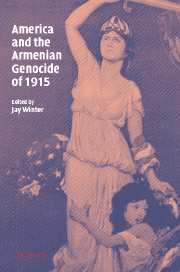Book contents
- Frontmatter
- Contents
- List of contributors
- Map
- Acknowledgments
- Introduction: witness to genocide
- Part 1 The framework
- Part II During the Catastrophe
- 4 A friend in power? Woodrow Wilson and Armenia
- 5 Wilsonian diplomacy and Armenia: the limits of power and ideology
- 6 American diplomatic correspondence in the age of mass murder: the Armenian Genocide in the US archives
- 7 The Armenian Genocide and American missionary relief efforts
- 8 Mary Louise Graffam: witness to genocide
- 9 From Ezra Pound to Theodore Roosevelt: American intellectual and cultural responses to the Armenian Genocide
- Part III After the Catastrophe
- Index
- Studies in the Social and Cultural History of Modern Warfare
9 - From Ezra Pound to Theodore Roosevelt: American intellectual and cultural responses to the Armenian Genocide
Published online by Cambridge University Press: 04 September 2009
- Frontmatter
- Contents
- List of contributors
- Map
- Acknowledgments
- Introduction: witness to genocide
- Part 1 The framework
- Part II During the Catastrophe
- 4 A friend in power? Woodrow Wilson and Armenia
- 5 Wilsonian diplomacy and Armenia: the limits of power and ideology
- 6 American diplomatic correspondence in the age of mass murder: the Armenian Genocide in the US archives
- 7 The Armenian Genocide and American missionary relief efforts
- 8 Mary Louise Graffam: witness to genocide
- 9 From Ezra Pound to Theodore Roosevelt: American intellectual and cultural responses to the Armenian Genocide
- Part III After the Catastrophe
- Index
- Studies in the Social and Cultural History of Modern Warfare
Summary
The response of American intellectuals and cultural leaders to the Armenian Genocide of 1915 can be seen as a landmark in American modernity and a prologue to twentieth-century American engagement in human rights disasters in the international arena. But that outpouring of social and political opinion was not without its antecedents: for the American narrative concerning the Armenian atrocities committed by the Ottoman Turks began in 1894, at the start of Sultan Abdul-Hamid's massacres, which took the lives of about 200,000 Armenians in 1894–6.
During those years Americans from all classes and walks of life spoke out against the Hamidian Massacres. In 1896, the US House and Senate passed the Cullom Resolution, condemning the Sultan and his government for wholesale massacres of innocent Armenians. Women's groups, churches, synagogues, and civic organizations around the country organized to protest the treatment of the Armenians and to raise money for relief. The National Armenian Relief Committee, headed by American industrialists including Spencer Task and Jacob Schiff and supported by John D. Rockefeller, raised more than $300,000 in 1896–7. Clara Barton organised the first international Red Cross relief mission to the killing fields of the Armenian provinces in eastern Turkey in 1896. The Armenian atrocities were covered regularly by the nation's major newspapers and magazines throughout the nineties. In some cities, such as Minneapolis and St. Paul, Americans even boycotted Thanksgiving dinner in November of 1896 on behalf of fund raising for relief of “the starving Armenians.”
- Type
- Chapter
- Information
- America and the Armenian Genocide of 1915 , pp. 240 - 254Publisher: Cambridge University PressPrint publication year: 2004
- 2
- Cited by

